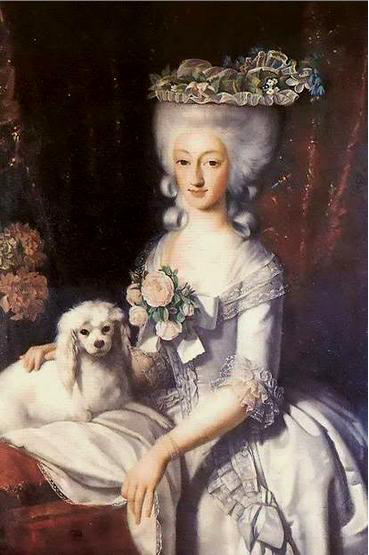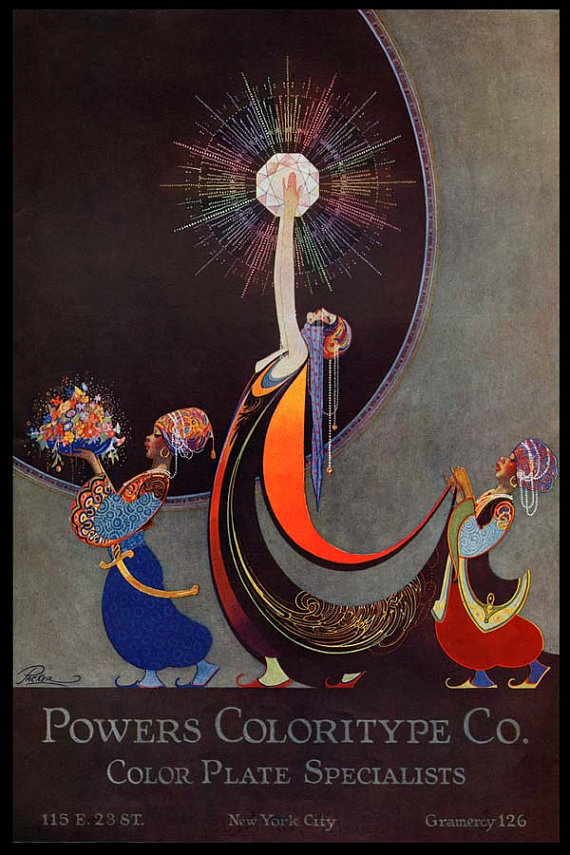Read the fascinating history of jewelry from our past. Starting with the Georgian Era, in the early 1700's, and up through the Retro Era, ending in the 1950's. See how jewelry styles have changed over time. Click on the 'read more' link to see pictures of jewelry from that time period. Go back in time and imagine yourself in each of these periods. After your journey, which jewelry period is your favorite?

Princess Maria Anna of Savoy, circa 1777. Artist unknown.
(Public domain; Wikimedia Commons)
Georgian (1714-1837)
- The Georgian Era
was characterized by the excesses and indulgences of the wealthy. This was the era of powdered wigs, grand balls and sparkling, over- the- top jewels. Those born into royal families and other very rich patrons were dripping with diamonds and other gemstones from newly discovered diamond and gem mines in the New World treasure trove of Brazil. read more

Victorians "On the Shores" by Alexander M. Rossi, 1887
(Public domain; Wikimedia Commons)
Victorian (1837-1901)
- The Victorian Era
was heavily influenced by the life and reign of Queen Victoria. It also ushered in the Industrial Revolution and the rise of the middle class. The ability to manufacture goods on a mass scale was a game changer. For the first time, it was not just the very wealthy who could afford fine jewelry and other luxuries in life. read more

Art Nouveau ceramic tile by Alfons Mucha, circa 1890.
(U.S public domain; Wikimedia Commons)
Art Nouveau (1890-1915)
- The Art Nouveau movement
began in late Victorian times. It was as an artistic backlash against industrialized society and the greedy overindulgence it could produce. It also struck out against the somber, oppressive atmosphere that seemed to weigh down the late Victorian era. The Art Nouveau movement helped usher in the less restrictive, less somber modern age of the 20th century. read more

Edwardian fashions
(Polyvore.com)
Edwardian (1901-1910)
- The Edwardian Era
was a time of great change and invention in society. For first time, it was acceptable for both men and women to work outside of the home. In 1901, the first telegraph signal was sent across the ocean. 1901 also marks the death of Queen Victoria. Instead of the mood remaining somber, Edwardian society adapted a more lighthearted tone. Queen Victoria's son, King Edward took over the British throne. read more

An Art Deco advertisement.
(Etsy.com)
Art Deco (1920-1939)
- The Art Deco movement
evolved during the roaring 1920s. This was the Jazz Age, a fast paced, hedonistic era centered on the pursuit of happiness and all that life could give a person. Prohibition was the law but that didn't stop people from drinking illegally. Flappers were young women coming of age who threw aside conventional behavior. They had no problem bellying up to the bar at speak-easies with the boys. read more

World War II women's recruiting poster.
(Seeingbeauty.wordpress.com)
Retro (1935-1950)
- The Retro Era
refers to the extended time period directly before, during and shortly after World War II. Millions of men were called into active duty to prevent Hitler from carrying out his evil plans. Women took over the men's jobs on the home front, ensuring that wartime factories remained productive. Patriotism, rationing and sacrifice were the words of the day. Everyone's mind was on the victory that had to come to keep the free world safe. read more
References:
A Collector's Guide to Costume Jewelry: Key Styles and How to Recognize Them by Tracey Tolkien and Henrietta Wilkinson, Firefly Books, 1997
Antique Jewellery by John Benjamin, Antique Collectors' Club Ltd., 2003
Collecting Victorian Jewelry: Identification and Price Guide by Jeanenne C. Bell, KP books, 2004
Popular Jewelry: 1840-1940 by Roseann Ettinger, Schiffer Publishing, Ltd., 2002
The History of Diamond Cuts: Yates Jewelers, 2015
www.langantiques.com/university
www.preciousplatinum.in/platinum-history
www.topazery.com/jewelry-periods.htm
Know someone who loves vintage jewelry? Share this with them!


